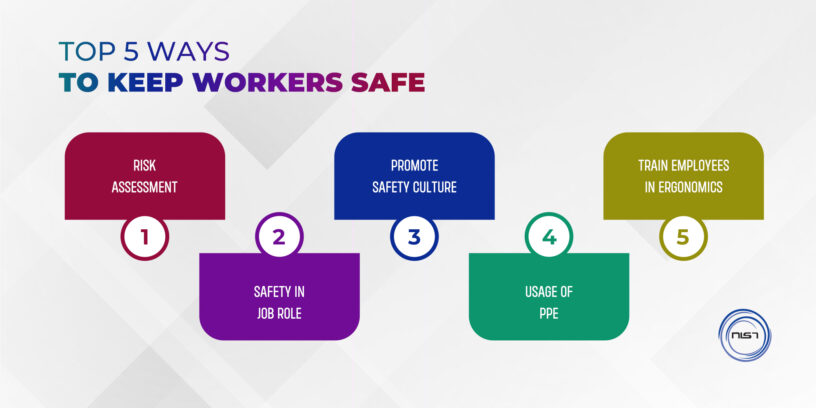Employer-led health and safety efforts are ultimately aimed at integrating safety into every facet of business. Employers have a vested interest in encouraging worker safety. A proactive strategy is necessary to keep workers safe. You might be wondering what safety initiatives you can put in place right away that will generate enough return on investment in the long run as you work to create workflows and procedures that improve employee safety at your company. Fortunately, there are a number of proactive measures that almost pay for themselves to keep staff safe. Others use cutting-edge technology to enable prompt triage in the event of a workplace safety issue. Some programmes are about maintaining the demands of a safety culture in new ways. Here are 5 practical safety measures you can put in place at work.
- Risk Assessment
The cornerstone of any effective programme to avoid workplace injuries is risk management. Human risk is a variable that shifts daily in the workplace. Because hazards change, these programmes need constant upkeep to maintain their efficacy.
It makes a strong case for the need for more frequent risk assessments. The challenge with more frequent safety evaluations is time. They frequently only exist on an annual or possibly quarterly basis. Going beyond the annual risk assessment, which is the absolute minimum need, is crucial since the regulatory environment changes along with human safety variables.
For your company to be able to make adjustments immediately to enhance worker safety, we advise doing monthly risk assessments. This can involve anything from a blocked fire entrance to routinely watching how workers move large objects, what safety equipment they wear, and what kinds of repetitive activities they perform.
- Safety in Job role
A safety standard should be included in the job description for every role. By doing this, one can create a culture of safety that openly discusses risk and ways to reduce it. A complete job safety analysis that incorporates better occupational health and safety concepts into every position in your firm is necessary to provide these recommendations.
To keep your employees safer, you are essentially developing a set of detailed guidelines for each function in your business. In three ways, this procedure pays for itself:
- Making safety a job requirement lowers the total risk of serious injury to the firm.
- Employees are proactively retrained to stay away from repetitive tasks that are bad for their health.
- By showcasing how hard your organisation works to protect its employees, you attract recruits.
Work with managers, operations, and engineering as necessary to find ways to lower those risks after observing personnel in various positions and departments to identify potential harm risks. In the end, preventing workplace safety mishaps is the goal.
- Promote Safety Culture
In risk management circles, safety culture ought to be more than simply a trendy phrase. The idea is that better safety procedures can and need to be implemented throughout your company. This calls for:
- A shared purpose that transcends financial gain. The mission should be the primary priority of the organisation, along with employee safety.
- Commitment from all levels of organisational stakeholders.
- At every level of the employee life cycle, from discussing safety with job prospects through enforcement by senior management, learning is continuously reinforced.
- Accountability at all levels for workplace security. This must be combined with a robust and prompt response to any events that do arise, demonstrating to workers that you actually value their input.
A safety culture is a long journey toward a new way of thinking that realigns your company’s principles. It drives everything a company with a strong safety culture does.
- Usage of PPE
PPE is more than just something that must be worn in compliance with OSHA regulations. Two of the effective tools you have to help employees stay safe on the workplace are PPE and employee education. For instance, wearing protective headgear while working can reduce the risk of several head injuries. Similarly, ear protection can assist your staff in maintaining their hearing as they age. Obviously, it can be difficult to make sure employees follow PPE regulations. The next time you notice employees not using their PPE, inquire as to why. Employees frequently wear outdated or uncomfortable safety equipment.
As you research new PPE, think about getting feedback from your staff. Give your staff the chance to test out any upgraded equipment you’re thinking about. This will not only allow them to become a little more at ease with the equipment they must wear, but will also encourage regular discussion among your employees about workplace safety issues like PPE compliance. Better still if you can provide customers with their choice between two or three gear models. By letting employees express themselves, you demonstrate that you appreciate their personality and interests in addition to their safety.
- Train employees in Ergonomics
The majority of workplace injuries nowadays are ergonomic, or those that involve the musculoskeletal system of the body. The best way to avoid repetitive motion injuries and strains of the ligaments, muscles, and tendons is to create an ergonomics work plan for your company.
By identifying habits and work procedures that can be adjusted to safeguard your workers from these all-too-common workplace injuries, ergonomics programmes aim to reduce the strain on the body. To assist avoid MSK injuries, engineering ergonomics for your workplace needs three key considerations:
- Workstation assessments to alter layouts for your teams’ increased comfort and security
- Administrative practises that lessen stress, such reducing the amount of overtime or lengthening breaks
- Possibilities to encourage the use of personal protective equipment (PPE) that guarantees safer movement, such as grip-enhancing gloves and anti-slip boots
Retraining your staff in good body mechanics and other ergonomic workplace rules is the only way to reduce dangers from awkward postures, improper lifting, full body vibration, and repetitive jobs.
Conclusion
The integration of safety into every part of the organisation is the ultimate goal of employer-led health and safety efforts.
Reducing the likelihood of injuries will inevitably lower the costs of injuries and workers’ compensation claims that businesses must pay, money that can be used elsewhere to provide a productive and safe workplace for workers. Therefore, the key directive is for decision-makers to adopt a new mentality and carry out these five simple yet effective procedures. The sooner they do so, the better for staff health and business ROI.
NIST, being a leader in providing safety services, provides customized safety training for your organization. We help you train your employees on risk assessment or ergonomics in order to promote workplace safety. We also proffer safety auditing & consulting, HSE recruitment, staffing & managed services. Contact our client servicing team @ +91 9384663536 or mail us at corporate.sales@nistinstitute.com














Leave a Reply